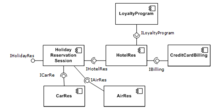In distributed computing, a remote procedure call (RPC) is when a computer program causes a procedure (subroutine) to execute in a different address space, which is written as if it were a normal (local) procedure call, without the programmer explicitly writing the details for the remote interaction. That is, the programmer writes essentially the same code whether the subroutine is local to the executing program, or remote. This is a form of client–server interaction, typically implemented via a request–response message passing system. In the object-oriented programming paradigm, RPCs are represented by remote method invocation (RMI). The RPC model implies a level of location transparency, namely that calling procedures are largely the same whether they are local or remote, but usually, they are not identical, so local calls can be distinguished from remote calls. Remote calls are usually orders of magnitude slower and less reliable than local calls, so distinguishing them is important.
The Common Object Request Broker Architecture (CORBA) is a standard defined by the Object Management Group (OMG) designed to facilitate the communication of systems that are deployed on diverse platforms. CORBA enables collaboration between systems on different operating systems, programming languages, and computing hardware. CORBA uses an object-oriented model although the systems that use the CORBA do not have to be object-oriented. CORBA is an example of the distributed object paradigm.
XML-RPC is a remote procedure call (RPC) protocol which uses XML to encode its calls and HTTP as a transport mechanism.
A web service (WS) is either:
The Web Services Invocation Framework (WSIF) supports a simple and flexible Java API for invoking any Web Services Description Language (WSDL)-described service.
The Data Distribution Service (DDS) for real-time systems is an Object Management Group (OMG) machine-to-machine standard that aims to enable dependable, high-performance, interoperable, real-time, scalable data exchanges using a publish–subscribe pattern.
XML Interface for Network Services (XINS) is an open-source technology for definition and implementation of internet applications, which enforces a specification-oriented approach.
Inter-Language Unification or ILU is a method for computer systems to exchange data, bridging differences in the way systems represent the various kinds of data. Even if two systems run on the same computer, or on identical computer hardware, many differences arise from the use of different computer languages to build the systems.
RMI-IIOP denotes the Java Remote Method Invocation (RMI) interface over the Internet Inter-Orb Protocol (IIOP), which delivers Common Object Request Broker Architecture (CORBA) distributed computing capabilities to the Java platform. It was initially based on two specifications: the Java Language Mapping to OMG IDL, and CORBA/IIOP 2.3.1.

Apache Axis2 is a web service engine. It is a redesign and re-write of the widely used Apache Axis SOAP stack. Implementations of Axis2 are available in Java and C.
Thrift is an IDL and binary communication protocol used for defining and creating services for programming languages. It was developed by Facebook. Since 2020, it is an open source project in the Apache Software Foundation.
Component Object Model (COM) is a binary-interface technology for software components from Microsoft that enables using objects in a language-neutral way between different programming languages, programming contexts, processes and machines.

The Web Services Description Language is an XML-based interface description language that is used for describing the functionality offered by a web service. The acronym is also used for any specific WSDL description of a web service, which provides a machine-readable description of how the service can be called, what parameters it expects, and what data structures it returns. Therefore, its purpose is roughly like a type signature in a programming language.

Avro is a row-oriented remote procedure call and data serialization framework developed within Apache's Hadoop project. It uses JSON for defining data types and protocols, and serializes data in a compact binary format. Its primary use is in Apache Hadoop, where it can provide both a serialization format for persistent data, and a wire format for communication between Hadoop nodes, and from client programs to the Hadoop services. Avro uses a schema to structure the data that is being encoded. It has two different types of schema languages: one for human editing and another which is more machine-readable based on JSON.
JSON-WSP is a web service protocol that uses JSON for service description, requests and responses. It is inspired from JSON-RPC, but the lack of a service description specification with documentation in JSON-RPC sparked the design of JSON-WSP.
Web IDL is an interface description language (IDL) format for describing APIs that are intended to be implemented in web browsers. Its adoption was motivated by the desire to improve the interoperability of web programming interfaces by specifying how languages such as ECMAScript should bind these interfaces.
gRPC is a cross-platform high-performance remote procedure call (RPC) framework. gRPC was initially created by Google, but is open source and is used in many organizations. Use cases range from microservices to the "last mile" of computing. gRPC uses HTTP/2 for transport, Protocol Buffers as the interface description language, and provides features such as authentication, bidirectional streaming and flow control, blocking or nonblocking bindings, and cancellation and timeouts. It generates cross-platform client and server bindings for many languages. Most common usage scenarios include connecting services in a microservices style architecture, or connecting mobile device clients to backend services.
Cap’n Proto is a data serialization format and Remote Procedure Call (RPC) framework for exchanging data between computer programs. The high-level design focuses on speed and security, making it suitable for network as well as inter-process communication. Cap'n Proto was created by the former maintainer of Google's popular Protocol Buffers framework and was designed to avoid some of its perceived shortcomings.



